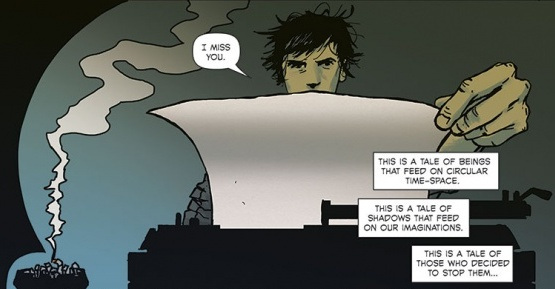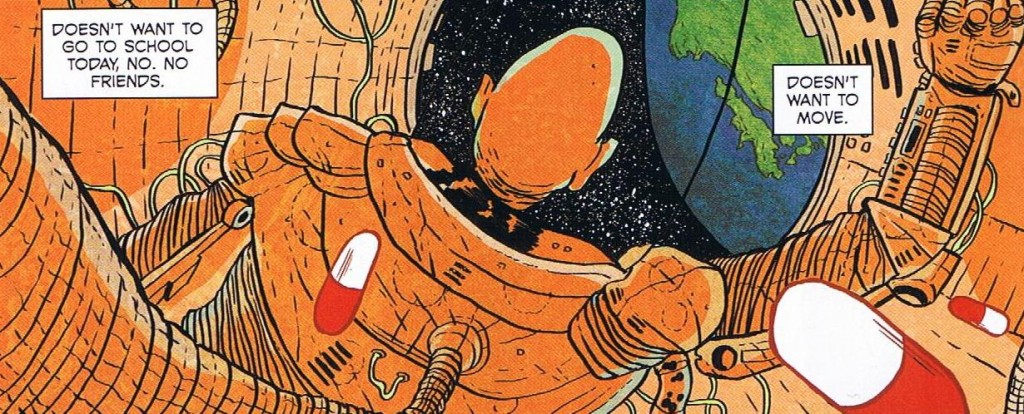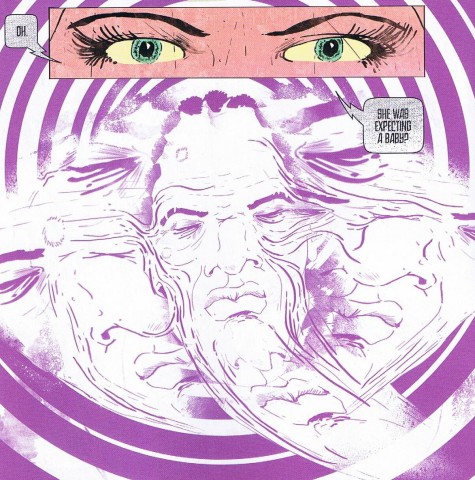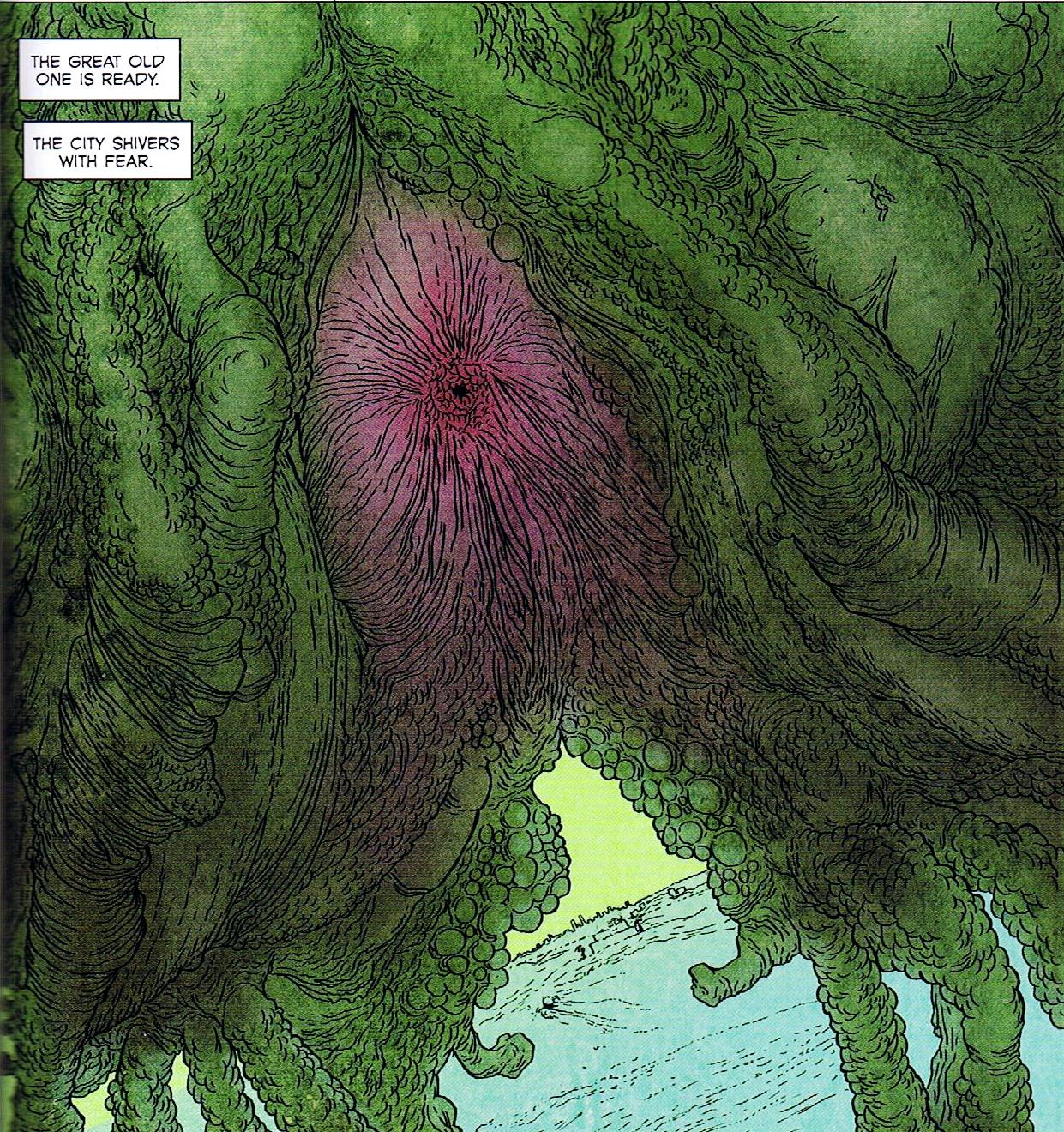Scan barcode
ratgrrrl's review
challenging
dark
inspiring
mysterious
sad
tense
medium-paced
- Plot- or character-driven? A mix
- Strong character development? It's complicated
- Loveable characters? It's complicated
- Flaws of characters a main focus? It's complicated
5.0
I genuinely have absolutely no idea, but I absolutely loved it and need to read it a few more time to have a clue what was going on.
jekutree's review
2.0
Borderline incoherent but there is something salvageable from this book. I really dig the art, the paneling, the coloring and the lettering, my main problems are with the plot and writing. Stuff kinda just happens and I’m sure there’s deeper elements I’m missing but the plot wasn’t engaging in my opinion.
A comic with a cerebral style of storytelling in my opinion has to be somewhat appealing on a surface level. That’s where books like Flex Mentallo and The Invisibles shine, they are approachable. I think this book isn’t very approachable.
4/10
A comic with a cerebral style of storytelling in my opinion has to be somewhat appealing on a surface level. That’s where books like Flex Mentallo and The Invisibles shine, they are approachable. I think this book isn’t very approachable.
4/10
thecolourblue's review
challenging
dark
funny
medium-paced
- Plot- or character-driven? A mix
- Strong character development? No
- Loveable characters? No
- Diverse cast of characters? No
- Flaws of characters a main focus? Yes
2.75
I read this when I realised it was a prequel of sorts to The Surface, which I prefer both in aesthetics and writing to this series.
The plot is pretty nonsencical, which is not a criticism per se - I generally like cerebral, surrealist comics. But this one felt a bit overwrought and ego-driven. The art though is fantastic, and there's some panels and pages that manage to be both mind-expandingly sublime and grossly funny.
I would have rated this 2.5, but the art is good enough to bump it up the extra 1/4 star.
The plot is pretty nonsencical, which is not a criticism per se - I generally like cerebral, surrealist comics. But this one felt a bit overwrought and ego-driven. The art though is fantastic, and there's some panels and pages that manage to be both mind-expandingly sublime and grossly funny.
I would have rated this 2.5, but the art is good enough to bump it up the extra 1/4 star.
annaonthepage's review
adventurous
challenging
dark
mysterious
sad
tense
slow-paced
- Plot- or character-driven? Plot
- Strong character development? It's complicated
- Loveable characters? No
- Diverse cast of characters? Yes
- Flaws of characters a main focus? No
I haven't the faintest idea what happened in this book.
Graphic: Gun violence, Body horror, and Violence
robin_dh's review
challenging
dark
emotional
funny
mysterious
reflective
sad
medium-paced
- Plot- or character-driven? A mix
- Strong character development? Yes
- Loveable characters? Yes
- Diverse cast of characters? Yes
- Flaws of characters a main focus? Yes
3.5
nearit's review
4.0
EXPOSITION: From the first few pages onwards it’s clear that this is one of those LA stories, an everyday apocalypse in which a strung out and savvy cast of screenwriters, rappers, astronauts, agents and cultists collide against a genre-mashed backdrop; the prophetic screenplay that drives the story is modeled on The Last Boy Scout, but Richard Kelly’s media-frazzled sci-fi meltdown Southland Tales seems the more fitting tonal counterpoint for this story of a city stuck on an apparently endless cycle of destruction.
You might remember reading about all this in the early hype, but if not you can always obtain the first issue for free online and get a flavour for it yourself.
The main characters in CHANGE are lost and ambitious souls, tilting after people and projects like a set of modern day Don Quixotes, struggling to find their way to an imaginary elsewhere that might just resemble home if they can stick the landing.
If there’s a criticism to be raised here it’s perhaps that the women in this comic tend to be framed at the centre of the madness, while the men are given more active roles as explorers. Richard Doublehead (“the Virginia Woolf of screenwriters”) and rapper turned movie producer W-2 and find themselves instigating the plot and exploring it respectively, and in their dueling roles both men are spurred on by the loss of their partners. Charlie Kaufman style maverick screenwriter and surprisingly competent car thief Sonia has a more active role than either of the female love interests, but her ability to write what’s about to happen still positions her as being somehow in tune with the madness where her fellow protagonists affect and are affected by it:
Thinking about Sonia’s character, I keep coming back to Angela Carter talking about her experience with the surrealists:
If Sonia has anything, it’s vision, but somehow her goals seem less tangible those of her male counterparts; for all that her voice is the most purely entertaining one in the comic, I still can’t help but feel that her arc is also the least satisfying. Even the astronaut, who spends most of his page time cut off from the other characters, finds himself on a journey to be reunited with them and with himself:
DEVELOPMENT: The great strength of this comic is that Ales Kot seems to trust and understand his collaborators, who provide page after page of the sort of vivid physical and mental trauma that the script demands. Morgan Jeske’s gloriously repugnant linework supplies the former, grounding the book in the world of the flesh even as symbolism and psychedelia threaten to overwhelm reality:
If, as the narration claims, CHANGE is a story about “beings who feed on circular space-time”, perhaps it makes sense that it packs a startling amount of physical decay into its four issues/that it plays out like a Vine video in which kids turn to skeletons and back again in the blink of an eye. Most previously available examples of Jeske’s work had a slick PulpHope vibe to them, but whether the demands of the story or the shift in technique (this was the first comic he drew entirely on his Clintiq tablet, apparently) guided his hand provide this level of rotten sensuality, the book wouldn't be half as effective without it.
Sloane Leong’s hot, queasy colours make the psychic devastation every bit as inescapable as the physical decay on display. Compelling as the heightened reality of the first issue is, the latter parts of the story are far more ambitious, forgoing vain mimetics in favour of blazing artifice and making use of the full possibilities of colouring in a way that few contemporary pop comics artists have either the head or the heart for.
Take the following excerpt, in which a couple cycle through a series of sickly colour shifts during a sequence of startling intimacy:
I praised Jeske for bringing ugliness to this book a few paragraphs ago, but these panels make it obvious that he provides a lot of genuinely beautiful images too. I'm particularly fond of the second panel above, where Doublehead's arm seem to expand towards infinity at the bottom of the frame, promising an equally endless supply of comfort in the process. Still, while Jeske and Kot provide a jumble of overlapping moments that add up to an intensely tender portrait of young love, Leong makes sure that the "sepsis" that taints this story is present throughout, corrupting the past with the sickness of events yet to come.
As the series goes on you can detect the confidence of the art team increasing, and this brings out the best in Kot, who seems to know that whatever nuances of story that aren’t conveyed between the art and the fragments of text he scatters on top of it are all the more suggestive for being trapped between the two:
Working together like this the CHANGE crew maintain a tone of disorientated clarity: narration and dialogue from one plot thread bleeds over another, sometimes punning on the visuals in a style that's been popular since Alan Moore's beard first screamed "Look ma, it's art!" (see above), but more often blurring the boundaries between different narratives until they finally converge in the cathartic finale. The sense of synaesthetic overload is palpable, to the extent that you might not quite be sure which sense is being triggered and which is being simulated in the end.
RECAPITULATION: Speaking of endings, let's... let's just throw a little *SPOILER* warning in the air, so we can all feel comfortable living through this one.
If the first issue of CHANGE established a lived-in vision of LA that echoed many of its fictional representations, and if the second and third issues saw this vision corrupted by the desperate longing in the hearts of its male characters (seriously, check the way the characters move from realised locations to toxic soulscapes as the story progresses) then the fourth and final issue threatened to obscure the whole thing by ramming it up the arsehole of a Lovecraftian monstrosity:
Thankfully neither the "Great Old One" nor his bowel movements can entirely obscure the emotional throughline of Change. The grotty texture of Jeske's line finds its apex in his depictions of the inner-workings of this unnameable, unimaginable thing, as Leong lets the unreality bleed out of her colours, all of it in the name of bringing everything together, of finding a way out of the cycle of creation and destruction that haunts the book.
Doublehead's trip into the unspeakable beast's colon and back might initially feels like flatulent punchline to a threat that seemed genuinely real and terrifying when seen from the Astronaut's cockpit in issue #1...
...but it also provides a key insight into CHANGE's version of the apocalypse. CHANGE's tonal antecedent Southland Tales dealt with America's toxic interventions in global politics in terms of the harm it had done to America itself (rather than, say, Iraq) and CHANGE follows suit for the most part, with the hot Stiffler-on-Stiffler reconciliation of Southland Tales' finale being echoed in the pile up of alternate Doubleheads that we find here, a rapid blur of collisions and separations that ends with a kiss:
Words flit through from a hospital beside bleached white with memory, Doublehead's mother, speaking to her son after a failed suicide bid: "People don't actually forget things. You'll just have to live with it instead."
CHANGE, then, is an attempt to deal with childhood trauma, an acknowledgement that some things never really get better, a letter to lost loves, an attempt to imagine back into being that which has been forever lost, and - FINALLY - a stealth account of an earnest attempt to care for someone with mental health issues. It's also a story in which the failure to deal with seemingly irresolvable problems becomes a seemingly irresolvable problem of its own. The transformation of otherworldly horror into a process of the body can be seen as a a description of the way internal pressures can end up feeling like the rot at the heart of everything one day and a manageable condition the next.
And so as Richard Doublehead staggers out of the ocean, fresh from giving his inner Patrick McGoohan a good seeing too, everything seems possible: "Nothing is too beautiful to happen," we're told. "Nothing is too good to last." It's a welcome reminder that the seemingly inescapable horrors of our current condition aren't "just" facts of life, but the CHANGE team are careful make sure that we know it's never quite as easy as that:
Sonia wakes up with a hole in her head, still perfectly in tune with the madness of the world.
Doublehead looks out over the city and sees a cycle broken, a world of possibility laid out before his feet.
But W-2? Shit, that poor bastard just gets to go home to an empty bed.
The apocalypse is averted in the end but comic book time -- the source of potentially limitless energy in Kot’s debut, Wild Children -- provides the blight of eternal recurrence for the reader. The only way to properly break the cycle, to stop this loop from existing in its complete form until the sun melts the ground beneath our feet, would be to travel the world burning every copy of this comic you could get your hands on and smashing every device that holds a digital copy.
Failing that, you'll just have to learn to live with (through?) it, just like the comic said, safe in the knowledge that it could be you who's left lying on your own at the end of this rotation, dreaming up new ways for the world to end...
***
Soundtrack:
Marnie Stern – ‘The Year of the Glad’
Marnie Stern – ‘Nothing Is Easy’
Marnie Stern – ‘Hell Yes’
You might remember reading about all this in the early hype, but if not you can always obtain the first issue for free online and get a flavour for it yourself.

The main characters in CHANGE are lost and ambitious souls, tilting after people and projects like a set of modern day Don Quixotes, struggling to find their way to an imaginary elsewhere that might just resemble home if they can stick the landing.
If there’s a criticism to be raised here it’s perhaps that the women in this comic tend to be framed at the centre of the madness, while the men are given more active roles as explorers. Richard Doublehead (“the Virginia Woolf of screenwriters”) and rapper turned movie producer W-2 and find themselves instigating the plot and exploring it respectively, and in their dueling roles both men are spurred on by the loss of their partners. Charlie Kaufman style maverick screenwriter and surprisingly competent car thief Sonia has a more active role than either of the female love interests, but her ability to write what’s about to happen still positions her as being somehow in tune with the madness where her fellow protagonists affect and are affected by it:

Thinking about Sonia’s character, I keep coming back to Angela Carter talking about her experience with the surrealists:
...I had to give them up in the end. They were, with a few patronized exceptions, all men and they told me that I was the source of all mystery, beauty, and otherness, because I was a woman – and I knew that was not true. I knew I wanted my fair share of the imagination, too. Not an excessive amount, mind; I wasn't greedy. Just an equal share in the right to vision.
If Sonia has anything, it’s vision, but somehow her goals seem less tangible those of her male counterparts; for all that her voice is the most purely entertaining one in the comic, I still can’t help but feel that her arc is also the least satisfying. Even the astronaut, who spends most of his page time cut off from the other characters, finds himself on a journey to be reunited with them and with himself:

DEVELOPMENT: The great strength of this comic is that Ales Kot seems to trust and understand his collaborators, who provide page after page of the sort of vivid physical and mental trauma that the script demands. Morgan Jeske’s gloriously repugnant linework supplies the former, grounding the book in the world of the flesh even as symbolism and psychedelia threaten to overwhelm reality:

If, as the narration claims, CHANGE is a story about “beings who feed on circular space-time”, perhaps it makes sense that it packs a startling amount of physical decay into its four issues/that it plays out like a Vine video in which kids turn to skeletons and back again in the blink of an eye. Most previously available examples of Jeske’s work had a slick PulpHope vibe to them, but whether the demands of the story or the shift in technique (this was the first comic he drew entirely on his Clintiq tablet, apparently) guided his hand provide this level of rotten sensuality, the book wouldn't be half as effective without it.
Sloane Leong’s hot, queasy colours make the psychic devastation every bit as inescapable as the physical decay on display. Compelling as the heightened reality of the first issue is, the latter parts of the story are far more ambitious, forgoing vain mimetics in favour of blazing artifice and making use of the full possibilities of colouring in a way that few contemporary pop comics artists have either the head or the heart for.
Take the following excerpt, in which a couple cycle through a series of sickly colour shifts during a sequence of startling intimacy:

I praised Jeske for bringing ugliness to this book a few paragraphs ago, but these panels make it obvious that he provides a lot of genuinely beautiful images too. I'm particularly fond of the second panel above, where Doublehead's arm seem to expand towards infinity at the bottom of the frame, promising an equally endless supply of comfort in the process. Still, while Jeske and Kot provide a jumble of overlapping moments that add up to an intensely tender portrait of young love, Leong makes sure that the "sepsis" that taints this story is present throughout, corrupting the past with the sickness of events yet to come.
As the series goes on you can detect the confidence of the art team increasing, and this brings out the best in Kot, who seems to know that whatever nuances of story that aren’t conveyed between the art and the fragments of text he scatters on top of it are all the more suggestive for being trapped between the two:

Working together like this the CHANGE crew maintain a tone of disorientated clarity: narration and dialogue from one plot thread bleeds over another, sometimes punning on the visuals in a style that's been popular since Alan Moore's beard first screamed "Look ma, it's art!" (see above), but more often blurring the boundaries between different narratives until they finally converge in the cathartic finale. The sense of synaesthetic overload is palpable, to the extent that you might not quite be sure which sense is being triggered and which is being simulated in the end.
RECAPITULATION: Speaking of endings, let's... let's just throw a little *SPOILER* warning in the air, so we can all feel comfortable living through this one.
If the first issue of CHANGE established a lived-in vision of LA that echoed many of its fictional representations, and if the second and third issues saw this vision corrupted by the desperate longing in the hearts of its male characters (seriously, check the way the characters move from realised locations to toxic soulscapes as the story progresses) then the fourth and final issue threatened to obscure the whole thing by ramming it up the arsehole of a Lovecraftian monstrosity:

Thankfully neither the "Great Old One" nor his bowel movements can entirely obscure the emotional throughline of Change. The grotty texture of Jeske's line finds its apex in his depictions of the inner-workings of this unnameable, unimaginable thing, as Leong lets the unreality bleed out of her colours, all of it in the name of bringing everything together, of finding a way out of the cycle of creation and destruction that haunts the book.
Doublehead's trip into the unspeakable beast's colon and back might initially feels like flatulent punchline to a threat that seemed genuinely real and terrifying when seen from the Astronaut's cockpit in issue #1...

...but it also provides a key insight into CHANGE's version of the apocalypse. CHANGE's tonal antecedent Southland Tales dealt with America's toxic interventions in global politics in terms of the harm it had done to America itself (rather than, say, Iraq) and CHANGE follows suit for the most part, with the hot Stiffler-on-Stiffler reconciliation of Southland Tales' finale being echoed in the pile up of alternate Doubleheads that we find here, a rapid blur of collisions and separations that ends with a kiss:

Words flit through from a hospital beside bleached white with memory, Doublehead's mother, speaking to her son after a failed suicide bid: "People don't actually forget things. You'll just have to live with it instead."
CHANGE, then, is an attempt to deal with childhood trauma, an acknowledgement that some things never really get better, a letter to lost loves, an attempt to imagine back into being that which has been forever lost, and - FINALLY - a stealth account of an earnest attempt to care for someone with mental health issues. It's also a story in which the failure to deal with seemingly irresolvable problems becomes a seemingly irresolvable problem of its own. The transformation of otherworldly horror into a process of the body can be seen as a a description of the way internal pressures can end up feeling like the rot at the heart of everything one day and a manageable condition the next.
And so as Richard Doublehead staggers out of the ocean, fresh from giving his inner Patrick McGoohan a good seeing too, everything seems possible: "Nothing is too beautiful to happen," we're told. "Nothing is too good to last." It's a welcome reminder that the seemingly inescapable horrors of our current condition aren't "just" facts of life, but the CHANGE team are careful make sure that we know it's never quite as easy as that:


Sonia wakes up with a hole in her head, still perfectly in tune with the madness of the world.
Doublehead looks out over the city and sees a cycle broken, a world of possibility laid out before his feet.
But W-2? Shit, that poor bastard just gets to go home to an empty bed.
The apocalypse is averted in the end but comic book time -- the source of potentially limitless energy in Kot’s debut, Wild Children -- provides the blight of eternal recurrence for the reader. The only way to properly break the cycle, to stop this loop from existing in its complete form until the sun melts the ground beneath our feet, would be to travel the world burning every copy of this comic you could get your hands on and smashing every device that holds a digital copy.
Failing that, you'll just have to learn to live with (through?) it, just like the comic said, safe in the knowledge that it could be you who's left lying on your own at the end of this rotation, dreaming up new ways for the world to end...
***
Soundtrack:
Marnie Stern – ‘The Year of the Glad’
Marnie Stern – ‘Nothing Is Easy’
Marnie Stern – ‘Hell Yes’
the_graylien's review
4.0
Wow. I've not even begun to scratch the surface of fully comprehending what's going on here, but this is a beautiful, haunting book.
marksutherland's review
3.0
As an Avant Garde experiment in comics this is definitely a success, it plays with the medium and the readers expectations in almost every way it can. But despite circling round a fairly powerful personal story, the end result is a bit of a mess and doesn't quite land the surrealist logic of Lynch et al. Technically brilliant but a bit overwrought.
More...